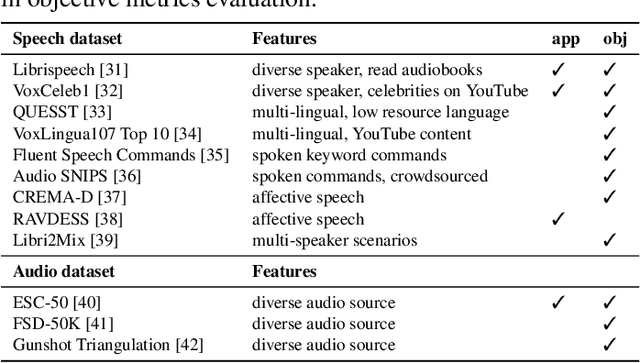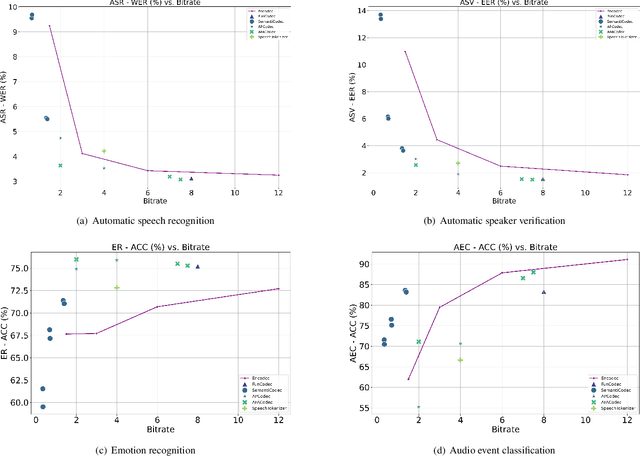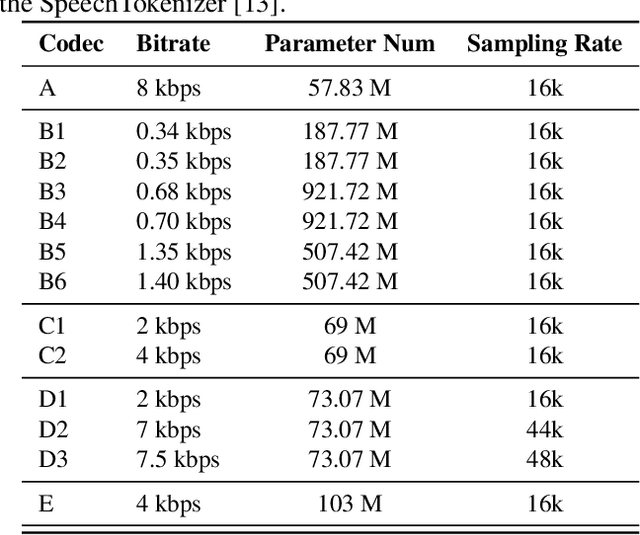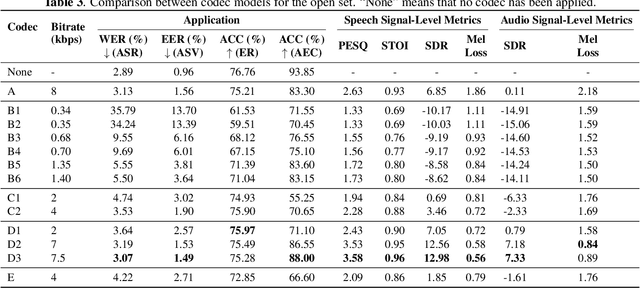Xu Tan
MoonCast: High-Quality Zero-Shot Podcast Generation
Mar 19, 2025Abstract:Recent advances in text-to-speech synthesis have achieved notable success in generating high-quality short utterances for individual speakers. However, these systems still face challenges when extending their capabilities to long, multi-speaker, and spontaneous dialogues, typical of real-world scenarios such as podcasts. These limitations arise from two primary challenges: 1) long speech: podcasts typically span several minutes, exceeding the upper limit of most existing work; 2) spontaneity: podcasts are marked by their spontaneous, oral nature, which sharply contrasts with formal, written contexts; existing works often fall short in capturing this spontaneity. In this paper, we propose MoonCast, a solution for high-quality zero-shot podcast generation, aiming to synthesize natural podcast-style speech from text-only sources (e.g., stories, technical reports, news in TXT, PDF, or Web URL formats) using the voices of unseen speakers. To generate long audio, we adopt a long-context language model-based audio modeling approach utilizing large-scale long-context speech data. To enhance spontaneity, we utilize a podcast generation module to generate scripts with spontaneous details, which have been empirically shown to be as crucial as the text-to-speech modeling itself. Experiments demonstrate that MoonCast outperforms baselines, with particularly notable improvements in spontaneity and coherence.
AudioX: Diffusion Transformer for Anything-to-Audio Generation
Mar 13, 2025Abstract:Audio and music generation have emerged as crucial tasks in many applications, yet existing approaches face significant limitations: they operate in isolation without unified capabilities across modalities, suffer from scarce high-quality, multi-modal training data, and struggle to effectively integrate diverse inputs. In this work, we propose AudioX, a unified Diffusion Transformer model for Anything-to-Audio and Music Generation. Unlike previous domain-specific models, AudioX can generate both general audio and music with high quality, while offering flexible natural language control and seamless processing of various modalities including text, video, image, music, and audio. Its key innovation is a multi-modal masked training strategy that masks inputs across modalities and forces the model to learn from masked inputs, yielding robust and unified cross-modal representations. To address data scarcity, we curate two comprehensive datasets: vggsound-caps with 190K audio captions based on the VGGSound dataset, and V2M-caps with 6 million music captions derived from the V2M dataset. Extensive experiments demonstrate that AudioX not only matches or outperforms state-of-the-art specialized models, but also offers remarkable versatility in handling diverse input modalities and generation tasks within a unified architecture. The code and datasets will be available at https://zeyuet.github.io/AudioX/
YuE: Scaling Open Foundation Models for Long-Form Music Generation
Mar 11, 2025Abstract:We tackle the task of long-form music generation--particularly the challenging \textbf{lyrics-to-song} problem--by introducing YuE, a family of open foundation models based on the LLaMA2 architecture. Specifically, YuE scales to trillions of tokens and generates up to five minutes of music while maintaining lyrical alignment, coherent musical structure, and engaging vocal melodies with appropriate accompaniment. It achieves this through (1) track-decoupled next-token prediction to overcome dense mixture signals, (2) structural progressive conditioning for long-context lyrical alignment, and (3) a multitask, multiphase pre-training recipe to converge and generalize. In addition, we redesign the in-context learning technique for music generation, enabling versatile style transfer (e.g., converting Japanese city pop into an English rap while preserving the original accompaniment) and bidirectional generation. Through extensive evaluation, we demonstrate that YuE matches or even surpasses some of the proprietary systems in musicality and vocal agility. In addition, fine-tuning YuE enables additional controls and enhanced support for tail languages. Furthermore, beyond generation, we show that YuE's learned representations can perform well on music understanding tasks, where the results of YuE match or exceed state-of-the-art methods on the MARBLE benchmark. Keywords: lyrics2song, song generation, long-form, foundation model, music generation
The Best of Both Worlds: Integrating Language Models and Diffusion Models for Video Generation
Mar 06, 2025Abstract:Recent advancements in text-to-video (T2V) generation have been driven by two competing paradigms: autoregressive language models and diffusion models. However, each paradigm has intrinsic limitations: language models struggle with visual quality and error accumulation, while diffusion models lack semantic understanding and causal modeling. In this work, we propose LanDiff, a hybrid framework that synergizes the strengths of both paradigms through coarse-to-fine generation. Our architecture introduces three key innovations: (1) a semantic tokenizer that compresses 3D visual features into compact 1D discrete representations through efficient semantic compression, achieving a $\sim$14,000$\times$ compression ratio; (2) a language model that generates semantic tokens with high-level semantic relationships; (3) a streaming diffusion model that refines coarse semantics into high-fidelity videos. Experiments show that LanDiff, a 5B model, achieves a score of 85.43 on the VBench T2V benchmark, surpassing the state-of-the-art open-source models Hunyuan Video (13B) and other commercial models such as Sora, Keling, and Hailuo. Furthermore, our model also achieves state-of-the-art performance in long video generation, surpassing other open-source models in this field. Our demo can be viewed at https://landiff.github.io/.
Llasa: Scaling Train-Time and Inference-Time Compute for Llama-based Speech Synthesis
Feb 06, 2025Abstract:Recent advances in text-based large language models (LLMs), particularly in the GPT series and the o1 model, have demonstrated the effectiveness of scaling both training-time and inference-time compute. However, current state-of-the-art TTS systems leveraging LLMs are often multi-stage, requiring separate models (e.g., diffusion models after LLM), complicating the decision of whether to scale a particular model during training or testing. This work makes the following contributions: First, we explore the scaling of train-time and inference-time compute for speech synthesis. Second, we propose a simple framework Llasa for speech synthesis that employs a single-layer vector quantizer (VQ) codec and a single Transformer architecture to fully align with standard LLMs such as Llama. Our experiments reveal that scaling train-time compute for Llasa consistently improves the naturalness of synthesized speech and enables the generation of more complex and accurate prosody patterns. Furthermore, from the perspective of scaling inference-time compute, we employ speech understanding models as verifiers during the search, finding that scaling inference-time compute shifts the sampling modes toward the preferences of specific verifiers, thereby improving emotional expressiveness, timbre consistency, and content accuracy. In addition, we released the checkpoint and training code for our TTS model (1B, 3B, 8B) and codec model publicly available.
ZSVC: Zero-shot Style Voice Conversion with Disentangled Latent Diffusion Models and Adversarial Training
Jan 08, 2025



Abstract:Style voice conversion aims to transform the speaking style of source speech into a desired style while keeping the original speaker's identity. However, previous style voice conversion approaches primarily focus on well-defined domains such as emotional aspects, limiting their practical applications. In this study, we present ZSVC, a novel Zero-shot Style Voice Conversion approach that utilizes a speech codec and a latent diffusion model with speech prompting mechanism to facilitate in-context learning for speaking style conversion. To disentangle speaking style and speaker timbre, we introduce information bottleneck to filter speaking style in the source speech and employ Uncertainty Modeling Adaptive Instance Normalization (UMAdaIN) to perturb the speaker timbre in the style prompt. Moreover, we propose a novel adversarial training strategy to enhance in-context learning and improve style similarity. Experiments conducted on 44,000 hours of speech data demonstrate the superior performance of ZSVC in generating speech with diverse speaking styles in zero-shot scenarios.
Next Token Prediction Towards Multimodal Intelligence: A Comprehensive Survey
Dec 30, 2024



Abstract:Building on the foundations of language modeling in natural language processing, Next Token Prediction (NTP) has evolved into a versatile training objective for machine learning tasks across various modalities, achieving considerable success. As Large Language Models (LLMs) have advanced to unify understanding and generation tasks within the textual modality, recent research has shown that tasks from different modalities can also be effectively encapsulated within the NTP framework, transforming the multimodal information into tokens and predict the next one given the context. This survey introduces a comprehensive taxonomy that unifies both understanding and generation within multimodal learning through the lens of NTP. The proposed taxonomy covers five key aspects: Multimodal tokenization, MMNTP model architectures, unified task representation, datasets \& evaluation, and open challenges. This new taxonomy aims to aid researchers in their exploration of multimodal intelligence. An associated GitHub repository collecting the latest papers and repos is available at https://github.com/LMM101/Awesome-Multimodal-Next-Token-Prediction
Predictor-Corrector Enhanced Transformers with Exponential Moving Average Coefficient Learning
Nov 05, 2024Abstract:Residual networks, as discrete approximations of Ordinary Differential Equations (ODEs), have inspired significant advancements in neural network design, including multistep methods, high-order methods, and multi-particle dynamical systems. The precision of the solution to ODEs significantly affects parameter optimization, thereby impacting model performance. In this work, we present a series of advanced explorations of Transformer architecture design to minimize the error compared to the true ``solution.'' First, we introduce a predictor-corrector learning framework to minimize truncation errors, which consists of a high-order predictor and a multistep corrector. Second, we propose an exponential moving average-based coefficient learning method to strengthen our higher-order predictor. Extensive experiments on large-scale machine translation, abstractive summarization, language modeling, and natural language understanding benchmarks demonstrate the superiority of our approach. On the WMT'14 English-German and English-French tasks, our model achieved BLEU scores of 30.95 and 44.27, respectively. Furthermore, on the OPUS multilingual machine translation task, our model surpasses a robust 3.8B DeepNet by an average of 2.9 SacreBLEU, using only 1/3 parameters. Notably, it also beats LLama models by 5.7 accuracy points on the LM Harness Evaluation.
CLaMP 2: Multimodal Music Information Retrieval Across 101 Languages Using Large Language Models
Oct 17, 2024



Abstract:Challenges in managing linguistic diversity and integrating various musical modalities are faced by current music information retrieval systems. These limitations reduce their effectiveness in a global, multimodal music environment. To address these issues, we introduce CLaMP 2, a system compatible with 101 languages that supports both ABC notation (a text-based musical notation format) and MIDI (Musical Instrument Digital Interface) for music information retrieval. CLaMP 2, pre-trained on 1.5 million ABC-MIDI-text triplets, includes a multilingual text encoder and a multimodal music encoder aligned via contrastive learning. By leveraging large language models, we obtain refined and consistent multilingual descriptions at scale, significantly reducing textual noise and balancing language distribution. Our experiments show that CLaMP 2 achieves state-of-the-art results in both multilingual semantic search and music classification across modalities, thus establishing a new standard for inclusive and global music information retrieval.
Codec-SUPERB @ SLT 2024: A lightweight benchmark for neural audio codec models
Sep 21, 2024



Abstract:Neural audio codec models are becoming increasingly important as they serve as tokenizers for audio, enabling efficient transmission or facilitating speech language modeling. The ideal neural audio codec should maintain content, paralinguistics, speaker characteristics, and audio information even at low bitrates. Recently, numerous advanced neural codec models have been proposed. However, codec models are often tested under varying experimental conditions. As a result, we introduce the Codec-SUPERB challenge at SLT 2024, designed to facilitate fair and lightweight comparisons among existing codec models and inspire advancements in the field. This challenge brings together representative speech applications and objective metrics, and carefully selects license-free datasets, sampling them into small sets to reduce evaluation computation costs. This paper presents the challenge's rules, datasets, five participant systems, results, and findings.
 Add to Chrome
Add to Chrome Add to Firefox
Add to Firefox Add to Edge
Add to Edge